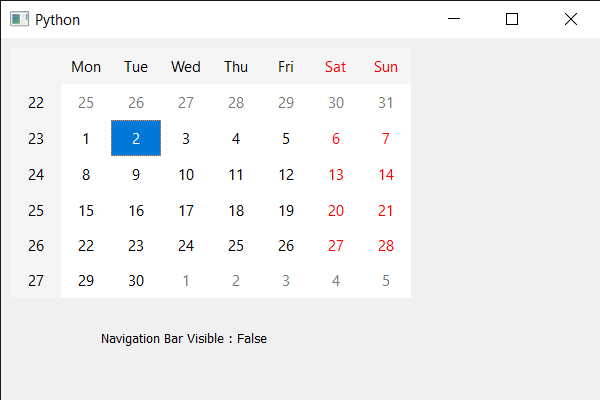En este artículo veremos cómo comprobamos si la barra de navegación del QCalendarWidget está visible o no. La barra de navegación es la sección superior del calendario que se utiliza para cambiar el mes siguiente, el mes anterior, la selección del mes y la selección del año. Por defecto, la barra de navegación está visible, aunque podemos ocultarla en cualquier momento con la ayuda del método setNavigationBarVisible, a continuación se muestra la representación de la barra de navegación de QCalendarWidget.

Para hacer esto, usaremos el método isNavigationBarVisible con el objeto QCalendarWidget.
Sintaxis: calendar.isNavigationBarVisible()
Argumento: no acepta ningún argumento
Retorno: devuelve bool
A continuación se muestra la implementación.
Python3
# importing libraries
from PyQt5.QtWidgets import *
from PyQt5 import QtCore, QtGui
from PyQt5.QtGui import *
from PyQt5.QtCore import *
import sys
class Window(QMainWindow):
def __init__(self):
super().__init__()
# setting title
self.setWindowTitle("Python ")
# setting geometry
self.setGeometry(100, 100, 600, 400)
# calling method
self.UiComponents()
# showing all the widgets
self.show()
# method for components
def UiComponents(self):
# creating a QCalendarWidget object
calendar = QCalendarWidget(self)
# setting geometry to the calendar
calendar.setGeometry(10, 10, 400, 250)
# hiding the navigation bar
calendar.setNavigationBarVisible(False)
# creating label
label = QLabel(self)
# setting geometry to the label
label.setGeometry(100, 270, 250, 60)
# making label multi line
label.setWordWrap(True)
# checking if the navigation bar is visible
check = calendar.isNavigationBarVisible()
# setting text to the label
label.setText("Navigation Bar Visible : " + str(check))
# create pyqt5 app
App = QApplication(sys.argv)
# create the instance of our Window
window = Window()
# start the app
sys.exit(App.exec())
Producción :

Publicación traducida automáticamente
Artículo escrito por rakshitarora y traducido por Barcelona Geeks. The original can be accessed here. Licence: CCBY-SA